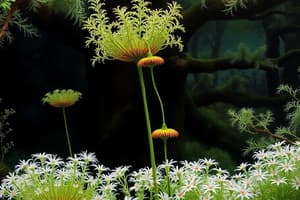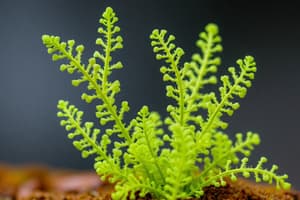Podcast
Questions and Answers
What is the primary function of the sporangium in pterophytes?
What is the primary function of the sporangium in pterophytes?
- To release the spores (correct)
- To provide structural support
- To produce male gametes
- To absorb water and nutrients
Which of the following describes the frond in a pterophyte?
Which of the following describes the frond in a pterophyte?
- It is the immature form of the sporophyte
- It is the reproductive organ of the plant
- It is the root structure for water absorption
- It functions as the ‘leaves’ and holds sori (correct)
What is the role of the prothallium in pterophytes?
What is the role of the prothallium in pterophytes?
- It produces female gametes
- It provides energy for the frond
- It absorbs water for the plant
- It produces male gametes (correct)
Which statement correctly describes gymnosperms?
Which statement correctly describes gymnosperms?
What distinguishes conifers from other gymnosperms?
What distinguishes conifers from other gymnosperms?
Which part of a gymnosperm is responsible for the growth of the zygote?
Which part of a gymnosperm is responsible for the growth of the zygote?
What are rhizoids primarily responsible for in pterophytes?
What are rhizoids primarily responsible for in pterophytes?
Which phylum contains the single surviving species Ginkgo biloba?
Which phylum contains the single surviving species Ginkgo biloba?
What is the primary characteristic that distinguishes bryophytes from other plant divisions?
What is the primary characteristic that distinguishes bryophytes from other plant divisions?
What role do rhizoids play in bryophytes?
What role do rhizoids play in bryophytes?
Which of the following statements about pterophytes is true?
Which of the following statements about pterophytes is true?
Which part of a bryophyte is responsible for spore dispersion?
Which part of a bryophyte is responsible for spore dispersion?
What is the key feature of pterophytes that allows them to grow larger than bryophytes?
What is the key feature of pterophytes that allows them to grow larger than bryophytes?
What are the leaves of bryophytes considered to be?
What are the leaves of bryophytes considered to be?
What is a sorus in the context of pterophytes?
What is a sorus in the context of pterophytes?
Why do bryophytes require moist environments for growth?
Why do bryophytes require moist environments for growth?
What is the main function of the megasporangium?
What is the main function of the megasporangium?
Which of the following best describes angiosperms?
Which of the following best describes angiosperms?
What does the androecium consist of?
What does the androecium consist of?
What is a defining feature of a sporophyte?
What is a defining feature of a sporophyte?
What is an antheridium responsible for?
What is an antheridium responsible for?
Which part of the angiosperm contains ovules?
Which part of the angiosperm contains ovules?
What distinguishes incomplete flowers from complete flowers?
What distinguishes incomplete flowers from complete flowers?
What differentiates angiosperms from gymnosperms?
What differentiates angiosperms from gymnosperms?
Flashcards
Bryophytes
Bryophytes
Non-vascular spore-bearing plants like mosses, lacking true roots but having rhizoids for anchoring.
Non-vascular plants
Non-vascular plants
Plants without xylem and phloem (conducting tissues) which limits their growth size.
Rhizoids
Rhizoids
Small hair-like structures in bryophytes that anchor the plant but do not absorb water.
Pterophytes
Pterophytes
Signup and view all the flashcards
Vascular plants
Vascular plants
Signup and view all the flashcards
Sorus
Sorus
Signup and view all the flashcards
Fronds
Fronds
Signup and view all the flashcards
Capsule
Capsule
Signup and view all the flashcards
Sporangium
Sporangium
Signup and view all the flashcards
Fiddlehead
Fiddlehead
Signup and view all the flashcards
Prothallium
Prothallium
Signup and view all the flashcards
Prothalus
Prothalus
Signup and view all the flashcards
Gymnosperm
Gymnosperm
Signup and view all the flashcards
Male Cone (Gymnosperm)
Male Cone (Gymnosperm)
Signup and view all the flashcards
Megasporangium
Megasporangium
Signup and view all the flashcards
Microsporangium
Microsporangium
Signup and view all the flashcards
Sporophyte
Sporophyte
Signup and view all the flashcards
Angiosperm
Angiosperm
Signup and view all the flashcards
Gynoecium
Gynoecium
Signup and view all the flashcards
Androecium
Androecium
Signup and view all the flashcards
Gametophyte
Gametophyte
Signup and view all the flashcards
Incomplete Flower
Incomplete Flower
Signup and view all the flashcards
Study Notes
Bryophytes
- Bryophytes are spore-bearing plants, like mosses, lacking true roots.
- They have rhizoids, small hair-like structures, to anchor them.
- Bryophytes are non-vascular, meaning they lack xylem and phloem for internal transport.
- They are moisture-dependent, needing water for survival and reproduction, as water aids spore dispersal.
- Their reproduction relies on spores.
Parts of Bryophytes
- Seta: A stalk supporting the capsule.
- Capsule: A structure containing and releasing spores.
- Leaves: Considered incomplete or untrue, compared to other plant types.
- Rhizoids: Function similar to roots, anchoring the plant but not absorbing water.
Pteridophytes
- Pteridophytes are spore-bearing plants with vascular systems (e.g., ferns, horsetails, whisk ferns).
- They have fronds, which are their leaves.
- They have vascular tissues (xylem and phloem).
- Sori are structures on the fronds that produce spores.
- Sporangia are the structures inside the sori that release spores.
- Rhizoids are used for absorption and anchoring.
Gymnosperms
- Gymnosperms produce seeds not enclosed within an ovary, typically in cones.
- They have a vascular system (xylem and phloem).
- Examples include conifers (e.g., pine trees), cycads, and Ginkgo.
- Gymnosperms reproduce using cones, with male and female cones for reproduction.
- Male cones produce pollen, and female cones develop seeds.
Angiosperms
- Angiosperms are seed plants with flowers and fruits.
- They have a vascular system (xylem and phloem).
- They are the most diverse group of plants.
- Angiosperms reproduce sexually through flowers which have male and female reproductive parts (and thus also seeds).
- Their reproductive parts include the gynoecium (female) and androecium (male), each having distinct subdivisions.
- Angiosperm reproduction produces a seed within a fruit.
Studying That Suits You
Use AI to generate personalized quizzes and flashcards to suit your learning preferences.




